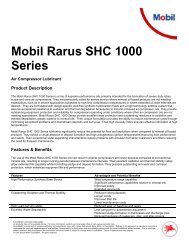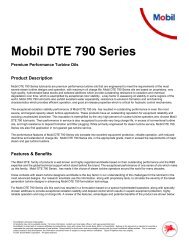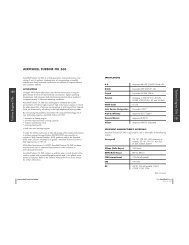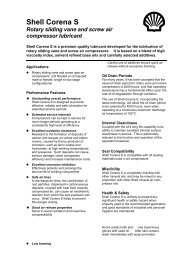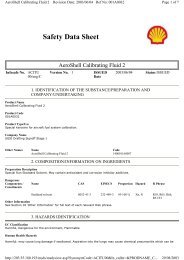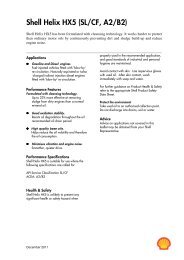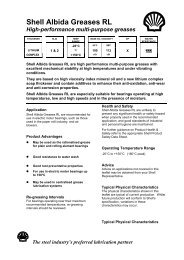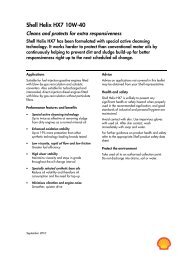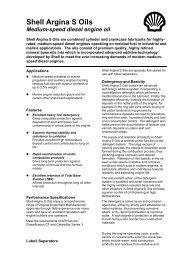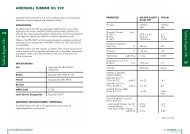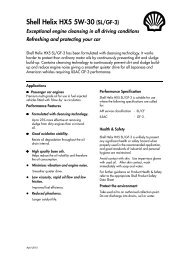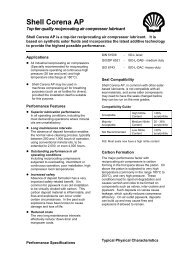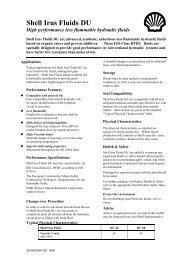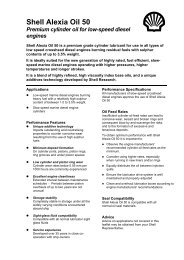Shell Thermia Oil A
Shell Thermia Oil A
Shell Thermia Oil A
You also want an ePaper? Increase the reach of your titles
YUMPU automatically turns print PDFs into web optimized ePapers that Google loves.
<strong>Shell</strong> <strong>Thermia</strong> <strong>Oil</strong> A<br />
Heat transfer fluid<br />
<strong>Shell</strong> <strong>Thermia</strong> <strong>Oil</strong> A is based on carefully selected highly refined mineral oils chosen<br />
for its ability to provide superior performance in indirect closed fluid heat transfer<br />
systems.<br />
Applications<br />
• Enclosed circulated heat transfer systems<br />
for industrial applications such as process<br />
industry, chemical plants, textile producers etc.<br />
and in household equipment such as oil filled<br />
radiators.<br />
<strong>Thermia</strong> A can be used in high temperature<br />
continuous heat transfer equipment with the following<br />
application limits:<br />
<strong>Thermia</strong> A<br />
Max. film temperature 280°C<br />
Max. bulk temperature 250°C<br />
<strong>Thermia</strong> A is suitable for use in systems running at<br />
lower temperatures and is especially recommended<br />
for combined heating-cooling systems that are<br />
allowed to cool.<br />
Performance Features and Benefits<br />
• High oxidation and thermal stability<br />
<strong>Thermia</strong> A is based on carefully selected highly<br />
refined mineral oils. The rates of oil cracking and<br />
oxidation are very small, giving long oil life. This<br />
assumes an efficient fluid heater with good pump<br />
circulation that the film temperatures on the heater<br />
surface do not exceed the limits above.<br />
• Low viscosity and high heat transfer<br />
coefficient<br />
Low viscosity enables excellent fluidity and heat<br />
transfer also at lower temperatures.<br />
• Good solvency<br />
• Non-corrosive<br />
• Low vapour pressure<br />
• Non-toxic oil and easy disposal<br />
Mineral oil heat transfer fluids are safer to handle<br />
than synthetic fluids. After service they can easily<br />
be collected as used oil for recycling or disposal.<br />
Specification and Approvals<br />
Classified as ISO 6743-12 Family Q<br />
Meets typically DIN 51522 requirements<br />
Advice<br />
The life of <strong>Thermia</strong> oils depends on the design<br />
and usage of the system. If the system is well<br />
designed and not subjected to abnormal<br />
workloads, the life can be for many years.<br />
It is important to monitor oil condition regularly as<br />
rates of change in physical characteristics are<br />
more significant than actual values. The properties<br />
that should be monitored are viscosity, acidity,<br />
flash point (open and closed) and insolubles<br />
content.<br />
Advice on applications not covered in this leaflet<br />
may be obtained from your <strong>Shell</strong> representative.<br />
Health and Safety<br />
Guidance on Health and Safety are available on<br />
the appropriate Material Safety Data Sheet which<br />
can be obtained from your <strong>Shell</strong> representative.<br />
Protect the environment<br />
Take used oil to an authorised collection point.<br />
Do not discharge into drains, soil or water.<br />
SEOP OECP/Po <strong>Thermia</strong> - page 1:2 01/09/2000
Typical Physical Characteristics<br />
<strong>Thermia</strong> A<br />
Density at 15 °C kg/m3 ISO 12185 893<br />
Flash Point PMCC °C ISO 2719 140<br />
Flash Point COC °C ISO 2592 150<br />
Fire Point COC °C ISO 2592 175<br />
Pour Point °C ISO 3016 -60<br />
Kinematic Viscosity ISO 3104<br />
at 0 °C mm2/s 48<br />
at 40 °C mm2/s 8.5<br />
at 100 °C mm2/s 2.2<br />
at 200 °C mm2/s 0.7<br />
Initial Boiling Point °C ISO 3771 285<br />
Autoignition Temperature °C DIN 51794 240<br />
Neutralisation Value mgKOH/g ASTM D974 < 0.05<br />
Water Content %m/m ISO 3733 < 0.1<br />
Ash (Oxid) %m/m ISO 6245 < 0.01<br />
Carbon Residue (Conradson) %m/m ISO 10370 < 0.02<br />
Copper Corrosion (3h/100°C) ISO 2160 class 1<br />
Coefficient of Thermal Expansion 1/°C 0.0008<br />
These characteristics are typical of current production. Whilst future production will conform<br />
to <strong>Shell</strong>'s specification, variations in these characteristics may occur.<br />
Typical Design Data - <strong>Thermia</strong> A:<br />
Temperature °C -20 0 20 40 100 150 200 250 280<br />
Density kg/m3 916 903 890 877 838 805 773 740 721<br />
Specific Heat Capacity kJ/kg*K 1.709 1.781 1.853 1.925 2.140 2.319 2.499 2.678 2.786<br />
Thermal Conductivity W/m*K 0.133 0.132 0.130 0.129 0.125 0.121 0.117 0.114 0.112<br />
Prandtl No. 2225 562 215 111 32 17 12 9 8<br />
SEOP OECP/Po <strong>Thermia</strong> - page 2:2 01/09/2000



